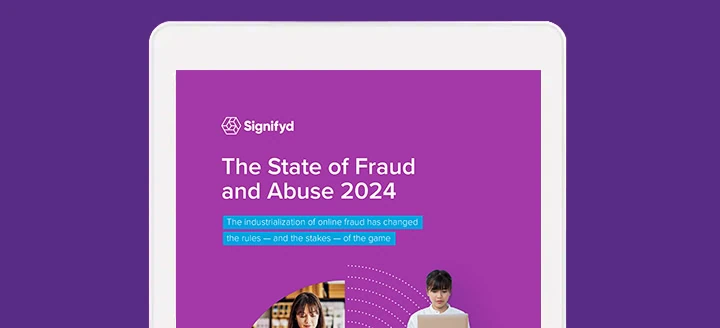As a chargeback analyst at Signifyd, I have an up-close view of the way chargeback abuse trends change over time.
The evolving trends are a steady reminder that for many, engaging in online fraud and abuse is a money-making venture and like any successful business it requires anticipating, adjusting and sometimes pivoting to stay a step ahead of the competition. In this case, I’m the competition. Well, me and Signifyd.
What is most interesting about my role in Chargebacks and Disputes is seeing how chargeback abuse trends change over time. I began working for Signifyd during COVID-19 when porch theft was a huge problem due to a shift towards non-contact deliveries.
Return abuse is on the rise and more diabolical
Now, we are seeing a lot more instances of returns abuse as well as an increase in trends whereby fraudsters are going the extra mile to obtain refunds by creating fake police reports and altering genuine tracking information on couriers’ websites (Fake Tracking ID Fraud) to make it look like they did not receive their goods. Identifying and successfully combating these trends is hugely rewarding and it is always great to see recoveries made on behalf of our merchants
I’ve been in a unique position to spot these trends and enjoy the satisfaction of protecting merchants’ revenue for three years working at Signifyd.

Source: Signifyd survey of 1,005 U.S. online consumers
It is my responsibility to review each chargeback to establish its validity and ensure that the customer is reimbursed when required, or to identify friendly fraud and create a rebuttal document containing compelling evidence. The document and evidence are used to refute the validity of the chargeback whilst ensuring that the cardholder doesn’t receive funds they are not entitled to at the expense of our merchants.
No two chargebacks are alike
Chargeback abuse has progressed a lot in the last few years and while on the surface chargebacks can look valid, there is nothing more satisfying than being able to evidence the abuse at play and ensure we are recovering on behalf of our clients.
I love the dynamic nature of my role — no two days are the same and I am constantly kept on my toes. You never know what you are going to be dealing with, whether it is a sudden spike in chargebacks that we need to understand the root cause of, investigating a high-dollar chargeback for signs of friendly fraud or assisting on calls with our clients to help with any issues or concerns they may have.
Like I said, you just never know. We recently worked with a merchant who became a victim of their own success when after 100 years in business, they suddenly gained a huge following on social media. All because a switch up in their marketing and product design turned an everyday item into an aesthetically pleasing, functional and must-have product. With influencers promoting the product online as a “necessity,” demand soared as the items were seen to be collectors’ items which people quite literally fought to get a hold of.
Keeping customers happy keeps chargebacks down
This rise in popularity caused a spike in sales for the merchant which left them struggling to fulfill orders, which in turn led to customer dissatisfaction.This then had a knock-on effect on their chargebacks and we saw a drastic increase in the amount of item not received and credit not processed claims. The former being just what it sounds like; the latter being a claim that a deserved refund, but was never granted one.
Within this population, our job was to work with the merchant to determine who was due a refund, and who was not entitled to their money back. However, amongst the delays, fraudsters saw an opportunity to make money from the merchant struggling to stay on top of their orders. The fraudsters started placing large quantities of orders, and initiating returns on each item. With the merchant so overwhelmed, they were unable to check inventory to see what was actually returned and what wasn’t, leading to refunds being processed erroneously where the merchandise wasn’t actually returned, as well as genuine refunds being missed for honest customers which resulted in valid chargebacks being raised.
Our chargeback team was able to identify the bad actors through trends in the order details like items ordered, delivery addresses and chargeback behavior, and we were able to alert the banks to the fraudulent behavior and recover the chargeback losses for the merchant.
Chargebacks increase with popularity and demand
Preparation is the key to success when it comes to avoiding chargebacks in these scenarios. If you are experiencing an increase in demand and anticipate launches to be popular then ensure that you have the stock and resources available to support that demand. Things don’t always go the way we want them to so if you are experiencing delays, be transparent — make your customers aware that you are experiencing delays and ensure that realistic timescales are provided for returns and refunds.
This then goes hand in hand with keeping policies up to date and visible; if your website says deliveries or refunds will be processed within a certain timeframe then that is what the customer expects. When these timeframes aren’t achieved, cardholders are more likely to raise a chargeback to get their funds back faster.
My last piece of advice would be to always remain alert and on the lookout for signs of chargeback abuse. This can be very easily overlooked especially during spikes in sales but this is when you become a prime target for consumer abuse.
Need help avoiding chargebacks? Let’s talk.












